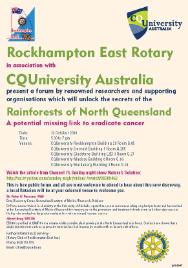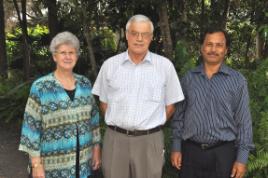Public invited to hear about new 'rainforest' cancer drug
Published on 22 October, 2010
Central Queenslanders can hear about a promising new rainforest-sourced cancer drug, during a presentation by Professor Peter Parsons on the evening of Friday, October 22...
LINK HERE FOR the latest event promotion
Professor Parsons heads the Drug Discovery group at the Queensland Institute of Medical Research (QIMR), which has been working with QBiotics on the new drug, EBC46.
In a joint project with Rotary (Rockhampton East), CQUniversity is hosting a presentation on EBC46, which has shown
LINK for a larger image amazing results in treating aggressive tumours in animals.
The new drug was discovered by two former CSIRO scientists, who are so passionate about the possibilities, they gave up their jobs 10 years ago to work full-time on this research privately in the Atherton Tablelands.
Professor Parsons will give a presentation on the research into this new drug on October 22 from 5.30pm to 7.30pm at CQUniversity in Rockhampton. The talk will be videolinked to Mackay, Emerald, Bundaberg and Gladstone.
EBC46 is purified at QIMR from the commercially scalable plant growing in the North Queensland rain forest.
A single treatment by injection into transplanted tumours in animal models, and into a range of spontaneous tumours in companion animals, has given promising results.
Watch Channel 7's Sunday Night program story on the drug below.
Few of the treated tumours have relapsed, with observation times being in the range 3-12 months so far. Normal tissue and structures are spared quite well and as far as they know at the moment it has no side effects.
Animal tumours prone to local recurrence after surgery generally don't come back after EBC46 treatment, suggesting that it causes destruction of the invading edges of the growth.
Much remains to be learnt about how the drug works but the Drug Discovery group has identified the primary target of the compound, and has clues about cell pathways that might explain its action.
EBC46 must be injected directly into the tumor, thus imaging and/or surgery will be required for treating internal tumours.
If a tumour has already spread to other parts of the body, EBC46 might still be useful for palliation, for example, by removing obstructive growths in the digestive tract.
Challenges for QIMR are to work out the mechanism of action of EBC46 and to prove whether it can be used for internal tumours.


